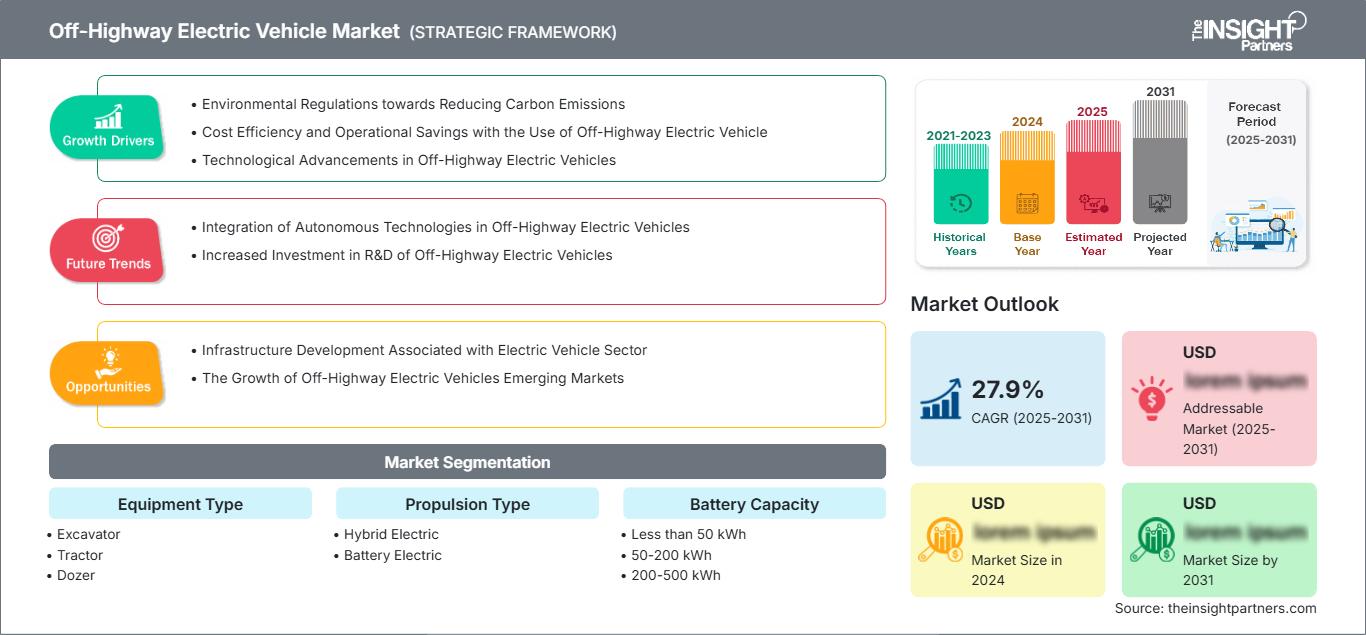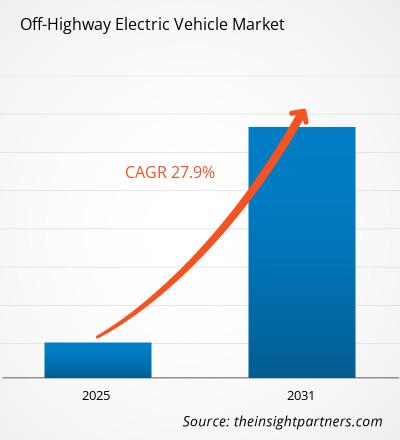Si prevede che il mercato dei veicoli elettrici fuoristrada registrerà un CAGR del 27,9% dal 2025 al 2031, con una dimensione del mercato in espansione da XX milioni di dollari nel 2024 a XX milioni di dollari entro il 2031.
Il rapporto è segmentato per tipo di attrezzatura (escavatore, trattore, bulldozer, caricatore, tosaerba, irroratrice, altri); tipo di propulsione (ibrido elettrico, elettrico a batteria); capacità della batteria (meno di 50 kWh, 50-200 kWh, 200-500 kWh, più di 500 kWh); applicazione (edilizia, estrazione mineraria, agricoltura). L'analisi globale è ulteriormente suddivisa a livello regionale e per i principali paesi. Il rapporto offre il valore in USD per l'analisi e i segmenti sopra indicati.
Scopo del rapporto
Il rapporto "Off-Highway Electric Vehicle Market" di The Insight Partners mira a descrivere il panorama attuale e la crescita futura, i principali fattori trainanti, le sfide e le opportunità. Ciò fornirà spunti a vari stakeholder aziendali, come:
- Fornitori/Produttori di tecnologia: per comprendere le dinamiche di mercato in evoluzione e conoscere le potenziali opportunità di crescita, consentendo loro di prendere decisioni strategiche informate.
- Investitori: per condurre un'analisi completa delle tendenze in merito al tasso di crescita del mercato, alle proiezioni finanziarie di mercato e alle opportunità esistenti lungo la catena del valore.
- Organismi di regolamentazione: per regolamentare le politiche e le attività di controllo sul mercato con l'obiettivo di ridurre al minimo gli abusi, preservare la fiducia degli investitori e sostenere l'integrità e la stabilità del mercato.
Segmentazione del mercato dei veicoli elettrici fuoristrada Tipo di attrezzatura
- Escavatore
- Trattore
- Bulldozer
- Caricatore
- Tosaerba
- Irroratrice
- Altri
Tipo di propulsione
- Ibrido elettrico
- Elettrico a batteria
Capacità della batteria
- Meno di 50 kWh
- 50-200 kWh
- 200-500 kWh
- Più di 500 kWh
Applicazione
- Edilizia
- Estrazione mineraria
- Agricoltura
Potrai personalizzare gratuitamente qualsiasi rapporto, comprese parti di questo rapporto, o analisi a livello di paese, pacchetto dati Excel, oltre a usufruire di grandi offerte e sconti per start-up e università
Mercato dei veicoli elettrici fuoristrada: Approfondimenti strategici

- Ottieni le principali tendenze chiave del mercato di questo rapporto.Questo campione GRATUITO includerà l'analisi dei dati, che vanno dalle tendenze di mercato alle stime e alle previsioni.
Fattori di crescita del mercato dei veicoli elettrici fuoristrada
- Normative ambientali volte a ridurre le emissioni di carbonio: la domanda di veicoli elettrici fuoristrada si baserà principalmente sulle normative ambientali che mirano a ridurre i livelli di emissione in queste applicazioni. I governi di tutto il mondo stanno elaborando normative che riducono le emissioni delle attrezzature edili, minerarie e agricole a livelli più sostenibili; pertanto, le aziende devono passare all'elettrico se vogliono rimanere entro tali parametri.
- Efficienza dei costi e risparmi operativi con l'uso di veicoli elettrici fuoristrada: in modo economicamente vantaggioso, riducendo i costi sostenuti per tali operazioni, queste macchine elettriche fuoristrada hanno generalmente costi operativi relativamente bassi rispetto alla controparte, essendo basate su motori diesel. Pertanto, attrae le aziende verso una soluzione conveniente che può offrire redditività e benefici ambientali, e quindi si nota una crescita in questo particolare segmento.
- Progressi tecnologici nei veicoli elettrici fuoristrada: i progressi nei veicoli elettrici fuoristrada continuano a essere sempre più praticabili e competitivi grazie al continuo miglioramento della tecnologia che coinvolge batterie e trasmissione elettrica. Una maggiore densità energetica, unita a una maggiore durata d'uso e a una ricarica più rapida, contribuiscono a rendere questi veicoli più efficienti e a garantire l'affidabilità e la produttività richieste nella maggior parte delle applicazioni industriali, attraendo un maggior numero di utenti.
Tendenze future del mercato dei veicoli elettrici fuoristrada
- Integrazione di tecnologie autonome nei veicoli elettrici fuoristrada: si sta assistendo a una tendenza verso le tecnologie autonome nel mercato dei veicoli elettrici fuoristrada. Le aziende stanno adottando sempre più l'automazione per garantire operazioni efficienti e sicure, soprattutto in contesti minerari e di costruzione. Le tecnologie elettriche e autonome si combinano, ridefinendo le dinamiche di mercato e, di conseguenza, stimolando l'innovazione.
- Maggiori investimenti in ricerca e sviluppo di veicoli elettrici fuoristrada: la tendenza crescente degli investimenti in ricerca e sviluppo di veicoli elettrici fuoristrada è relativamente forte. Le aziende stanno sviluppando soluzioni elettriche innovative che soddisfano specifici requisiti di settore, migliorano le prestazioni e aumentano la sostenibilità. Ciò accelera ulteriormente la crescita del mercato con l'aumento della concorrenza e delle tecnologie emergenti.
Opportunità di mercato per i veicoli elettrici fuoristrada
- Sviluppo delle infrastrutture associato al settore dei veicoli elettrici: la crescita delle infrastrutture elettriche con stazioni di ricarica e strutture di manutenzione specifiche per i veicoli elettrici fuoristrada offre notevoli opportunità per i produttori e i fornitori di servizi. Gli investimenti infrastrutturali sosterranno l'adozione in tutti i settori e, in generale, contribuiranno a migliorare l'efficienza operativa.
- La crescita dei veicoli elettrici fuoristrada nei mercati emergenti: penetrazione dei mercati emergenti in cui sono in corso lo sviluppo delle infrastrutture e l'industrializzazione. Una volta che questi mercati inizieranno a investire nell'aggiornamento delle flotte e delle attrezzature, i veicoli elettrici fuoristrada potranno rappresentare una delle alternative praticabili per i loro produttori che desiderano accedere a nuovi mercati di clienti, alla ricerca di soluzioni alternative rispettose dell'ambiente.
Mercato dei veicoli elettrici fuoristrada
Le tendenze e i fattori regionali che hanno influenzato il mercato dei veicoli elettrici fuoristrada durante il periodo di previsione sono stati ampiamente spiegati dagli analisti di The Insight Partners. Questa sezione analizza anche i segmenti e la geografia del mercato dei veicoli elettrici fuoristrada in Nord America, Europa, Asia-Pacifico, Medio Oriente e Africa, America meridionale e centrale.
Ambito del rapporto sul mercato dei veicoli elettrici fuoristrada
| Attributo del rapporto | Dettagli |
|---|---|
| Dimensioni del mercato in 2024 | US$ XX million |
| Dimensioni del mercato per 2031 | US$ XX Million |
| CAGR globale (2025 - 2031) | 27.9% |
| Dati storici | 2021-2023 |
| Periodo di previsione | 2025-2031 |
| Segmenti coperti |
By Tipo di attrezzatura
|
| Regioni e paesi coperti | Nord America
|
| Leader di mercato e profili aziendali chiave |
|
Densità degli operatori del mercato dei veicoli elettrici fuoristrada: comprendere il suo impatto sulle dinamiche aziendali
Il mercato dei veicoli elettrici fuoristrada è in rapida crescita, trainato dalla crescente domanda degli utenti finali, dovuta a fattori quali l'evoluzione delle preferenze dei consumatori, i progressi tecnologici e una maggiore consapevolezza dei vantaggi del prodotto. Con l'aumento della domanda, le aziende stanno ampliando la propria offerta, innovando per soddisfare le esigenze dei consumatori e sfruttando le tendenze emergenti, alimentando ulteriormente la crescita del mercato.

- Ottieni il Mercato dei veicoli elettrici fuoristrada Panoramica dei principali attori chiave
Punti di forza
- Copertura completa: il rapporto analizza in modo esaustivo prodotti, servizi, tipologie e utenti finali del mercato dei veicoli elettrici fuoristrada, offrendo una panoramica olistica.
- Analisi degli esperti: il rapporto è redatto sulla base della conoscenza approfondita di esperti e analisti del settore.
- Informazioni aggiornate: il rapporto garantisce la pertinenza aziendale grazie alla copertura di informazioni e dati recenti.
- Opzioni di personalizzazione: questo rapporto può essere personalizzato per soddisfare le esigenze specifiche del cliente e adattarsi in modo appropriato alle strategie aziendali.
Il rapporto di ricerca sul mercato dei veicoli elettrici fuoristrada può quindi contribuire a guidare il percorso di decodificazione e comprensione dello scenario del settore e delle prospettive di crescita. Sebbene possano esserci alcune valide preoccupazioni, i vantaggi complessivi di questo rapporto tendono a superare gli svantaggi.
- Analisi storica (2 anni), anno base, previsione (7 anni) con CAGR
- Analisi PEST e SWOT
- Valore/volume delle dimensioni del mercato - Globale, Regionale, Nazionale
- Industria e panorama competitivo
- Set di dati Excel
Report recenti
Rapporti correlati
Testimonianze
Motivo dell'acquisto
- Processo decisionale informato
- Comprensione delle dinamiche di mercato
- Analisi competitiva
- Analisi dei clienti
- Previsioni di mercato
- Mitigazione del rischio
- Pianificazione strategica
- Giustificazione degli investimenti
- Identificazione dei mercati emergenti
- Miglioramento delle strategie di marketing
- Aumento dell'efficienza operativa
- Allineamento alle tendenze normative




















 Ottieni un campione gratuito per - Mercato dei veicoli elettrici fuoristrada
Ottieni un campione gratuito per - Mercato dei veicoli elettrici fuoristrada